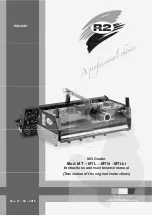
Never use the following on stainless steel:
Chemical spills, especially those agents listed here, should be removed as
soon as possible and the stainless steel surface cleaned with mild soapy
water followed by a distilled water rinse.
Anti-fungal and anti-bacterial additives are permissible to use as long as the
pH of the aqueous solution is kept within the range of 7 to 9. These are
available through laboratory distributors but be sure to CONFIRM that
they are not harmful to stainless steel.
Do not use any metallic pads. Instead, for stubborn stains, use a plastic
light duty cleansing pad and rub gently in the direction of the metal grain.
If stains continue to persist, use one of the following chemicals and
methods:
• Any of a variety of “scale removers” available at local supermarkets or
hardware stores used for the cleaning of coffee marks, humidifiers or
vaporizers.
• A 15% to 35% phosphoric acid solution is available from laboratory
supply distributors for scale and rust removal. Allow solution to soak
the surface affected until rust and scale is loosened. Immediately follow
with a distilled water rinse.
• Citric acid based cleaners.
• Bathroom tub and tile cleaners.
• A mixture of 20% nitric acid and 1.5% hydrofluoric acid (or
hyrochloric acid). Swab solution on surface allowing it to remain until
rust is loosened. Immediately follow with a distilled water rinse. This
method should ONLY be used if SEVERE rust and scale stains are
present.
• Oxalic acid 2% to 5% in warm water. Swab solution on surface
allowing it to remain until rust is loosened. Immediately follow with a
distilled water rinse. This method should ONLY be used if SEVERE
rust and scale stains are present.
MaxQ 7000 7-5
Thermo Scientific
Section 7
Maintenance
Special Considerations
(continued)
Aqua regia
Ferric chloride
Iodine
Sodium acid
Sodium azide
Cleansing Agents
Cleaning Methods








































